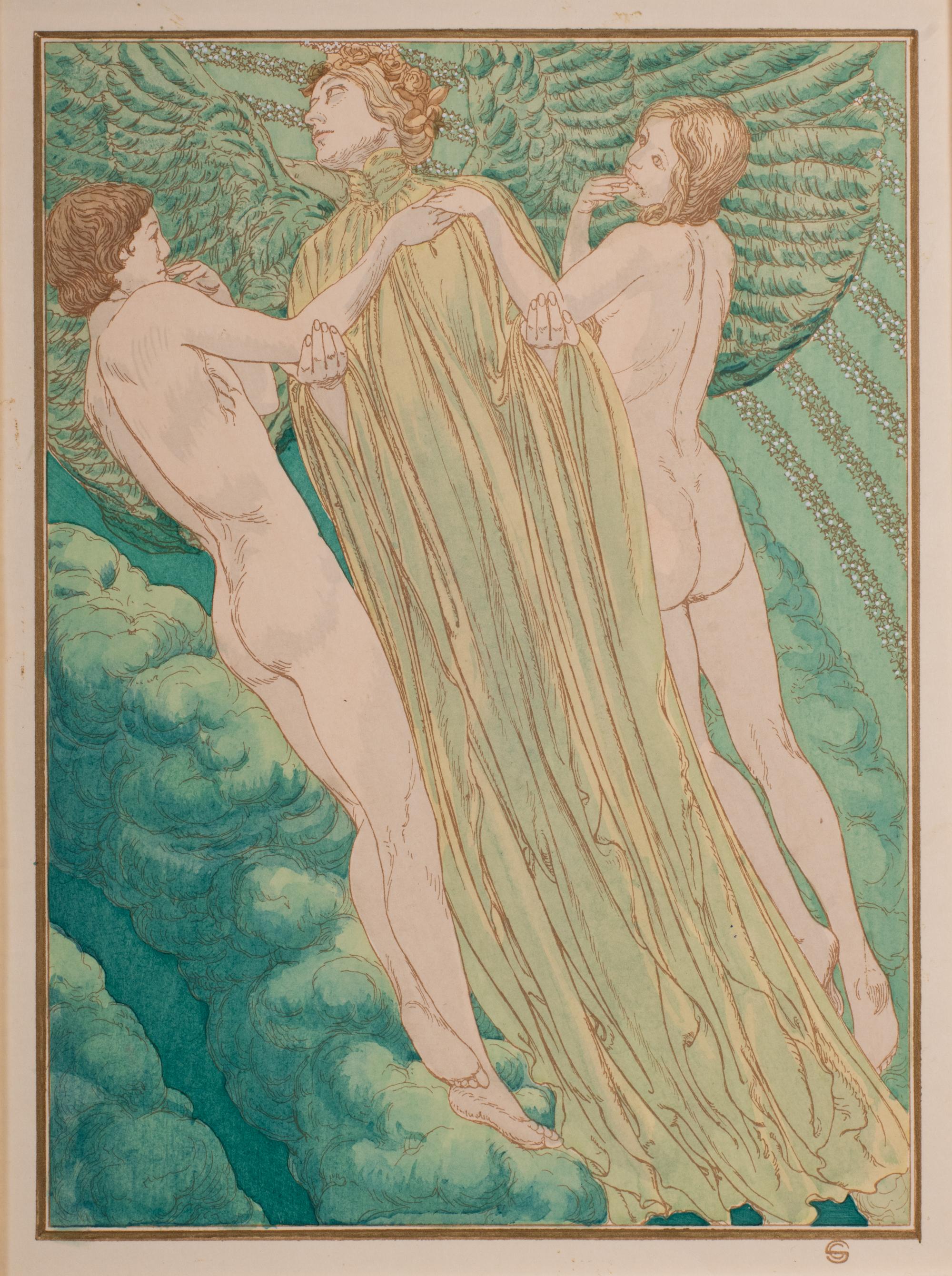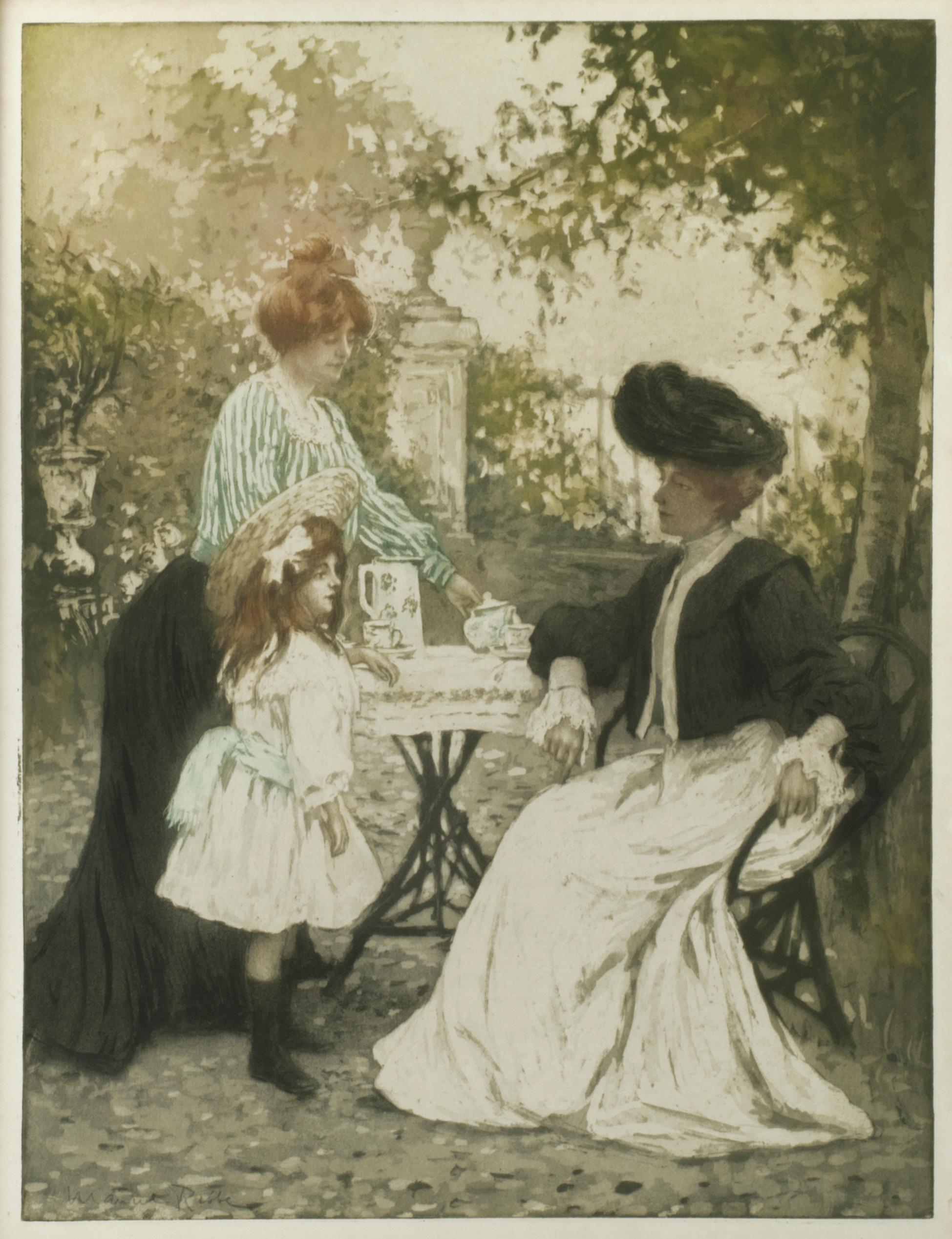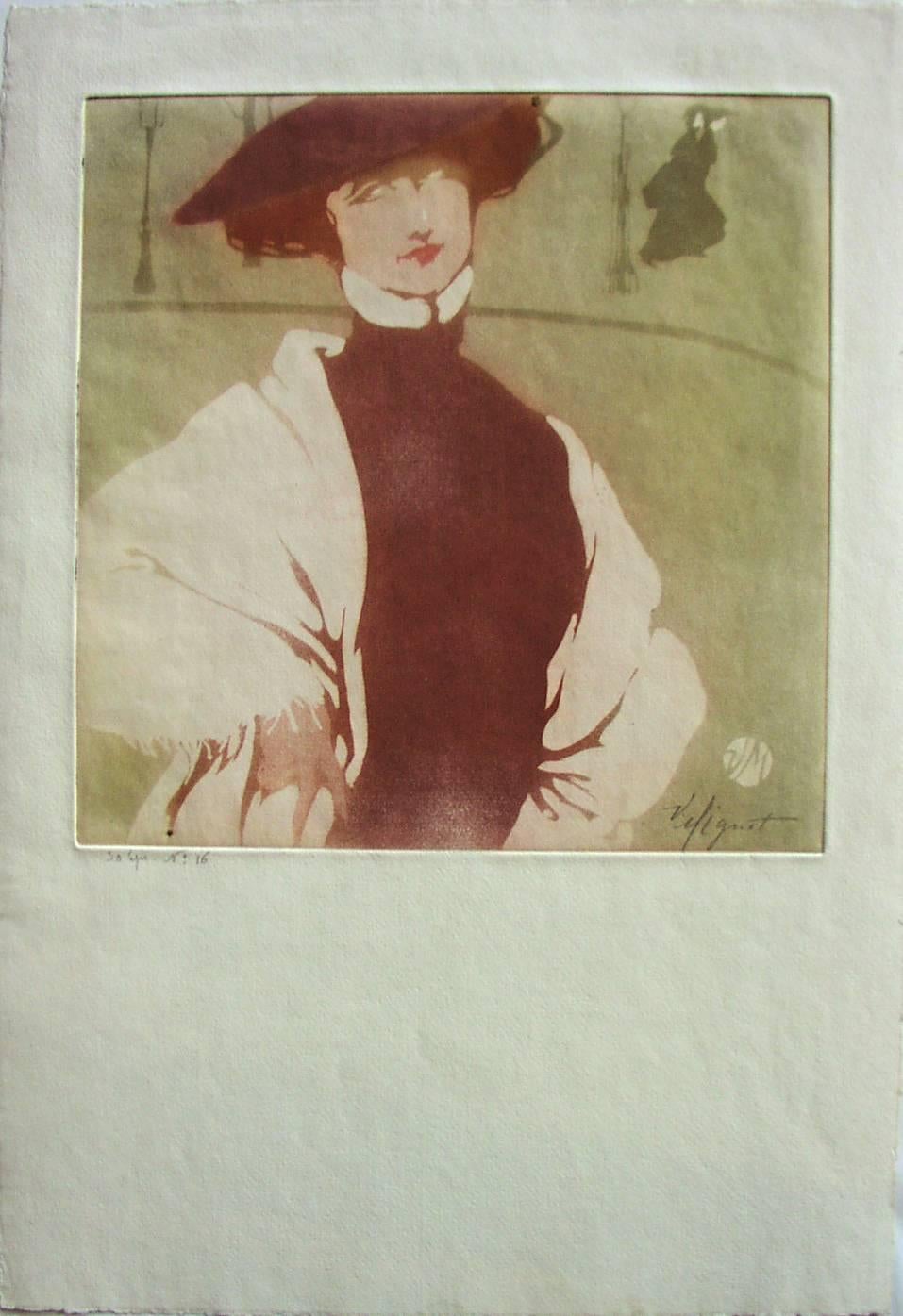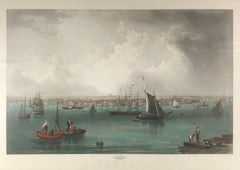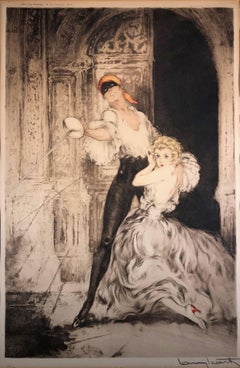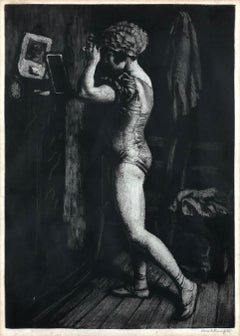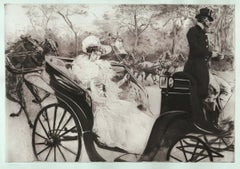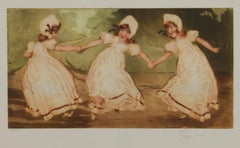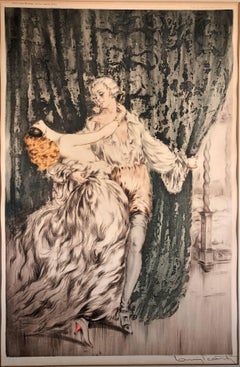
Casanova
View Similar Items
Want more images or videos?
Request additional images or videos from the seller
1 of 6
Louis IcartCasanova1928
1928
About the Item
- Creator:Louis Icart (1888 - 1950, French)
- Creation Year:1928
- Dimensions:Height: 28 in (71.12 cm)Width: 20.5 in (52.07 cm)
- Medium:
- Movement & Style:
- Period:
- Condition:Please email or call if you have questions or would like to see more detailed images.
- Gallery Location:Missouri, MO
- Reference Number:1stDibs: LU74732243493
Louis Icart
Louis Icart is considered to be a symbol of the Art Deco movement through his brilliant sketches and prints. Born in 1888 in Toulouse, France, his interest in art began at an early age. He was particularly drawn to fashion sketches and designs during the period when the fashion industry was undergoing a revolution from conservative 19th-century designs to the clingy simplicity of the early 20th century. Icart worked in major fashion studios where his L.I. initials on women’s clothing were highly regarded. While fighting in World War I, he continued to sketch on every available surface to ward off the anguish and agony of the war. He moved to Paris after the war to concentrate on painting and produced beautiful etchings. Icart’s prints were elaborate aquatints and drypoints done with great skill. They often portrayed women in sensual, erotic poses with an implication of direct sexuality. By the 1920s, the Art Deco movement had gained great popularity in Paris, France. Icart’s etchings and paintings, though largely influenced by Impressionists such as Claude Monet, were synonymous with the Art Deco era. His drawings also reflected the brilliance of Symbolists such as Gustave Moreau; however, Icart preferred not to be identified with artistic movements. His financial and artistic success came in the late 1920s. His work was featured in fashion publications and design studios in Europe and the United States. His immensely popular images, which were considered phenomenal by 1925, included "Laziness" and "Spilled Milk." Icart died on December 20, 1950, at his home in Montmartre, France.
About the Seller
5.0
Vetted Seller
These experienced sellers undergo a comprehensive evaluation by our team of in-house experts.
Established in 1970
1stDibs seller since 2017
141 sales on 1stDibs
Typical response time: 22 hours
More From This SellerView All
- BostonBy John William HillLocated in Missouri, MOJohn William Hill (1812-1879) "Boston" 1857 Hand-Colored Engraving Site Size: 29 x 41 inches Framed Size: 39 x 52 inches Born in London, England, John William Hill came to America with his family at age 7. His father, John Hill, was a well-known landscape painter, engraver, and aquatintist. John William had a career of two phases, a city topographer-engraver and then, the leading pre-Rafaelite school painter in this country. Employed by the New York Geological Survey and then by Smith Brothers...Category
1850s Pre-Raphaelite Landscape Prints
MaterialsAquatint, Engraving
Price Upon Request - Don JuanBy Louis IcartLocated in Missouri, MOAquating Engraving Image Size: approx. 20 1/4 x 13 3/8 Framed Size: 28 x 20.5 inches Pencil Signed Lower Right Louis Justin Laurent Icart was born in Toulouse in 1890 and died in Paris in 1950. He lived in New York City in the 1920s, where he became known for his Art-Deco color etchings of glamourous women. He was first son of Jean and Elisabeth Icart and was officially named Louis Justin Laurent Icart. The use of his initials L.I. would be sufficient in this household. Therefore, from the moment of his birth he was dubbed 'Helli'. The Icart family lived modestly in a small brick home on rue Traversière-de-la-balance, in the culturally rich Southern French city of Toulouse, which was the home of many prominent writers and artists, the most famous being Henri de Toulouse-Lautrec. Icart entered the l'Ecole Superieure de Commerce de Toulouse in order to continue his studies for a career in business, particularly banking (his father's profession). However, he soon discovered the play writings of Victor Hugo (1802-1885), which were to change the course of his life. Icart borrowed whatever books he could find by Hugo at the Toulouse library, devouring the tales, rich in both romantic imagery and the dilemmas of the human condition. It was through Icart's love of the theater that he developed a taste for all the arts, though the urge to paint was not as yet as strong for him as the urge to act. It was not until his move to Paris in 1907 that Icart would concentrate on painting, drawing and the production of countless beautiful etchings, which have served (more than the other mediums) to indelibly preserve his name in twentieth century art history. Art Deco, a term coined at the 1925 Paris Exposition des Arts Decoratifs, had taken its grip on the Paris of the 1920s. By the late 1920s Icart, working for both publications and major fashion and design studios, had become very successful, both artistically and financially. His etchings reached their height of brilliance in this era of Art Deco, and Icart had become the symbol of the epoch. Yet, although Icart has created for us a picture of Paris and New York life in the 1920s and 1930s, he worked in his own style, derived principally from the study of eighteenth-century French masters such as Jean Antoine Watteau, François Boucher and Jean Honoré Fragonard. In Icart's drawings, one sees the Impressionists Degas...Category
1920s Art Deco Figurative Prints
MaterialsEngraving, Aquatint
- The Circus Dressing RoomBy Dame Laura KnightLocated in Missouri, MODame Laura Knight (1877-1970) "The Circus Dressing Room" 1925 Aquatint Engraving Signed in Pencil Lower Right Image Size: approx 14 x 9 inches Framed Size: approx. 23.5 x 18.5 inche...Category
1920s Realist Figurative Prints
MaterialsAquatint, Engraving
Price Upon Request - In BrittanyBy Manuel RobbeLocated in Missouri, MOColor Engraving Image Size: approx 14 x 19.5 Framed Size: approx 21 x 26 3/4 Signed in Pencil Emmanuel Robbe called "Manuel Robbe", born in Paris on 16 December 1872 And died in Ne...Category
Early 1900s Impressionist Figurative Prints
MaterialsAquatint, Engraving
- In the BoudoirBy William AblettLocated in Missouri, MOAquating Engraving Image Size: Approx 19 x 15.5 Framed Size: Approx. 28.5 x 24.5 William Albert Ablett (1877 - 1937) Although born to English parents, William Ablett lived in Par...Category
Early 20th Century Art Deco Figurative Prints
MaterialsEngraving, Aquatint
Price Upon Request - The Circus Dressing RoomBy Dame Laura KnightLocated in Missouri, MODame Laura Knight "The Circus Dressing Room" 1925 Etching Ed. 20 Signed Lower Right Image Size: approx. 14 x 10 inches Framed Size: approx. 23.5 x 17.75 inches An English impressio...Category
1920s Realist Figurative Prints
MaterialsAquatint
You May Also Like
- La PromenadeBy Edgar ChahineLocated in Fairlawn, OHLa Promenade Etching, soft-ground, aquatint & drypoint, Signed in pencil lower left Published by Edmund Sagot, Paris Edition of 50 in black only, aside from the edition of 50 in co...Category
Early 1900s Art Nouveau Figurative Prints
MaterialsDrypoint, Etching, Aquatint
- Dornröschen (Sleeping Beauty.)By Heinrich VogelerLocated in Storrs, CTReif 20.IIc(of e). 10 5/8 x 9 3/4 (sheet 19 X 12 3/4). Slight scattered foxing in the margins, away from the image. A rich, tonal impression printed on sturdy wove paper. Proof aside...Category
Late 19th Century Jugendstil Figurative Prints
MaterialsFiberglass, Drypoint, Etching, Aquatint
$1,200 Sale Price20% Off - Heureux age! (Happy Age!)By Victor MignotLocated in Fairlawn, OHHeureux age! (Happy Age!) Etching and aquatint. c, 1900 Signed lower right in pencil Edition; 50 (14/50) Published by Edmund Sagot, Paris Sagot blindstamp, Lugt 2254, lower right Con...Category
Early 1900s Art Nouveau Figurative Prints
MaterialsAquatint
- Personages with LambsBy Sylvain SauvageLocated in San Francisco, CAThis artwork "Personages with Lambs" 1924 is an original colors aquatint by noted French artist Felix Roy A.K.A Sylvain Sauvage, 1888-1948. It is hand signed and numbered 88/350 in pencil by the artist. The image size is 13 x 9.5 inches, framed is 20 16 inches. Published and printed by La Societe Des Graveurs Modernes, Paris. Custom framed in a wooden gold frame. It is in excellent condition, especially considering the age of this artwork About the artist. Félix Roy, said Sylvain Sauvage (born in Baume-les-Messieurs ( Jura ) on May 8 , 1888 and died in Paris in January 1948 ) is an illustrator and technician of the French book. He was an exhibitor at the Salon des Artistes Décorateurs and Director of École Estienne . He illustrated many books of the French classic literature. The work of Sylvain Sauvage is held in numerous private collections in France and Europe. Selected books illustrated by the artist. L'Ingénue de Voltaire, Kieffer, 1922 La fille aux yeux d'or de Balzac, G. Crès, 1923 Monsieur Nicolas ou le cœur humain dévoilé. Mémoires intimes de Restif de la Bretonne, illustrés par Sylvain Sauvage de Restif de la Bretonne, Henri Jonquières, 1924 Les Belles Dames de Paris, historiettes de Tallemant de Réaux, coll. « Le livre du lettré », 1924 (avec une préface de Gérard Bauër) Anatole France, Les sept femmes de la Barbe Bleue et autres contes merveilleux, A.&G. Mornay, Paris, 1925 Marquis de Sade, Ernestine, Cabinet du Livre / Jean Fort Éditeur, Paris, 1926 : 10 eaux-fortes Casanova (J. de, Seigneur de Seingalt.), Une aventure de Casanova, Histoire complète de ses amours avec la belle C. C. et la religieuse de Muran. Compositions de Sylvain Sauvage gravées avec la collaboration de E. Feltesse. Paris, [chez l'artiste], 1926. Candide de Voltaire, chez l'Artiste (imprimé chez Frazier-Soye et Haasen), 1928 Les Dieux ont soif de Anatole France, Éditions du Nord, 1928 Le Bon Plaisir d’Henri de Régnier, La Roseraie, 1929 : 20 eaux-fortes en couleurs et vingt bois gravés La Troisième Jeunesse de madame Prune de Pierre Loti, Calmann-Levy, 1936 Les Romanesques ; Les Deux Pierrots ; La Dernière Nuit de Don Juan d’Edmond Rostand, éditions Pierre Laffitte, 1939 ; illustrations de Auguste Leroux...Category
Early 20th Century Art Nouveau Figurative Prints
MaterialsAquatint
- Danseuses s'habillant (Laurence adjusting her hair and Mignon adjusting clothesBy Louis LegrandLocated in Fairlawn, OHDanseuses s'habillant (Laurence adjusting her hair and Mignon adjusting hre clothes) Drypoint & aquatint, 1893 Signed in the plate (see photo) After the division of the plate into A. 81 (as here) and A. 82 Divant la glace Editon 100 printed on velin paper Issued by Pellet in the set, Les Petites du Ballet, Gustave Pellet editeur, 1893 (13 plates), second state (b) without remarque Reference: Arwas 81, top portion of the plate vii/VIII Plate/Image size: 6 x 8 7/16 inches Condition: excellent Louis Auguste Mathieu Legrand (29 September 1863 – 1951) was a French artist, known especially for his aquatint engravings, which were sometimes erotic. He was awarded the Légion d'honneur for his work in 1906. Life Legrand was born in the city of Dijon in the east of France. He worked as a bank clerk before deciding to study art part-time at Dijon's Ecole des Beaux-Arts. He won the Devosge prize at the school in 1883.[2] In 1884 Legrand studied engraving under the Belgian printmaker Félicien Rops. Legrand's artworks include etchings, graphic art and paintings. His paintings featured Parisian social life. Many were of prostitutes, dancers and bar scenes, which featured a sense of eroticism. According to the Hope Gallery, "Louis Legrand is simply one of France's finest early twentieth century masters of etching." His black and white etchings especially provide a sense of decadence; they have been compared to those of Henri de Toulouse-Lautrec, though his drawings of the Moulin Rouge, the can-can dance and the young women of Montmartre preceded Toulouse-Lautrec's paintings of similar scenes. He made over three hundred prints of the night life of Paris. They demonstrate "his remarkable powers of observation and are executed with great skill, delicacy, and an ironic sense of humor that pervades them all." Two of his satirical artworks caused him to be tried for obscenity. The first, "Prostitution" was a symbolic drawing which depicted a naked girl being grasped by a dark monster which had the face of an old woman and claws on its hands; the second, "Naturalism", showed the French novelist Émile Zola minutely studying the thighs of a woman with a magnifying glass. Defended by his friend the lawyer Eugène Rodrigues-Henriques (1853–1928), he was found not guilty in the lower court, but was convicted in the appeal court and then given a short prison sentence for refusing to pay his fine. Legrand was made famous by his colour illustrations for Gil Blas magazine's coverage of the can-can, with text by Rodrigues (who wrote under the pseudonym Erastene Ramiro). It was a tremendous success, with the exceptional quantity of 60,000 copies of the magazine being printed and instantly sold out in 1891. In 1892, at the instigation of the publishing house Dentu, Legrand made a set of etchings of his Gil Blas illustrations. The etchings were published in a book, Le Cours de Danse Fin de Siecle (The End of the Century Dance Classes). Legrand took a holiday in Brittany, which inspired him to engrave a set of fourteen lithographs of simple country life called Au Cap de la Chevre...Category
1890s Art Nouveau Figurative Prints
MaterialsAquatint
- L'Aieule (The Grandmother)By Louis LegrandLocated in Fairlawn, OHL'Aieule (The Grandmother) Etching and aquatint printed in colors, 1904 Signed with the red stamp of the publisher, Gustave Pellet, Lugt 1193 and numbered (see photo) Edition: 100 (81/100) Reference: Arwas 202 iv/IV IFF 98 Condition: Excellent, the sheet aged as usual Image size: 14 1/4 x 18 5/8" Sheet size: 16 15/16 x 24 1/4" Louis Auguste Mathieu Legrand (29 September 1863 – 1951) was a French artist, known especially for his aquatint engravings, which were sometimes erotic. He was awarded the Légion d'honneur for his work in 1906. Life Legrand was born in the city of Dijon in the east of France. He worked as a bank clerk before deciding to study art part-time at Dijon's Ecole des Beaux-Arts. He won the Devosge prize at the school in 1883.[2] In 1884 Legrand studied engraving under the Belgian printmaker Félicien Rops. Legrand's artworks include etchings, graphic art and paintings. His paintings featured Parisian social life. Many were of prostitutes, dancers and bar scenes, which featured a sense of eroticism. According to the Hope Gallery, "Louis Legrand is simply one of France's finest early twentieth century masters of etching." His black and white etchings especially provide a sense of decadence; they have been compared to those of Henri de Toulouse-Lautrec, though his drawings of the Moulin Rouge, the can-can dance and the young women of Montmartre preceded Toulouse-Lautrec's paintings of similar scenes. He made over three hundred prints of the night life of Paris. They demonstrate "his remarkable powers of observation and are executed with great skill, delicacy, and an ironic sense of humor that pervades them all." Two of his satirical artworks caused him to be tried for obscenity. The first, "Prostitution" was a symbolic drawing which depicted a naked girl being grasped by a dark monster which had the face of an old woman and claws on its hands; the second, "Naturalism", showed the French novelist Émile Zola minutely studying the thighs of a woman with a magnifying glass. Defended by his friend the lawyer Eugène Rodrigues-Henriques (1853–1928), he was found not guilty in the lower court, but was convicted in the appeal court and then given a short prison sentence for refusing to pay his fine. Legrand was made famous by his colour illustrations for Gil Blas magazine's coverage of the can-can, with text by Rodrigues (who wrote under the pseudonym Erastene Ramiro). It was a tremendous success, with the exceptional quantity of 60,000 copies of the magazine being printed and instantly sold out in 1891. In 1892, at the instigation of the publishing house Dentu, Legrand made a set of etchings of his Gil Blas illustrations. The etchings were published in a book, Le Cours de Danse Fin de Siecle (The End of the Century Dance Classes). Legrand took a holiday in Brittany, which inspired him to engrave a set of fourteen lithographs of simple country life called Au Cap de la Chevre (On Goat Promontory). It was published by Gustave Pellet who became a close friend of Legrand's. Pellet eventually published a total of 300 etchings by Legrand, who was his first artist; he also published Toulouse-Lautrec and Félicien Rops among others. He did not only work in graphics; he exhibited paintings at the Paris salon of the Société Nationale des Beaux-Arts starting in 1902. In 1906 he was made a chevalier of the Légion d'honneur. Legrand died in obscurity in 1951. A retrospective exhibition was held at the Félicien Rops museum in Namur, Belgium in 2006 to celebrate his graphic art. The art collector Victor Arwas published a catalogue raisonné for the occasion. Books illustrated de Maupassant, Guy: Cinq Contes Parisiens, 1905. Poe, Edgar Alan: Quinze Histoires d'Edgar Poe...Category
Early 1900s Art Nouveau Figurative Prints
MaterialsAquatint





